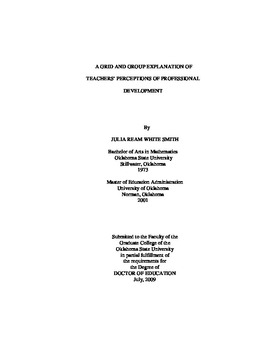| dc.contributor.advisor | Harris, Ed | |
| dc.contributor.author | Smith, Julia Ream White | |
| dc.date.accessioned | 2013-11-26T08:34:54Z | |
| dc.date.available | 2013-11-26T08:34:54Z | |
| dc.date.issued | 2009-07 | |
| dc.identifier.uri | https://hdl.handle.net/11244/7577 | |
| dc.description.abstract | Scope and Method of Study: The purpose of this inductive study was to use Mary Douglas' (1982) Typology of Grid and Group to explain the relationship between the organizational cultures of four Midwestern high schools and their teachers' satisfaction with professional development practices. Harris' (2005) description of school culture and associated professional development strategies, which are based on Douglas' typology, was also used to determine the types of professional development strategies used at each school. | |
| dc.description.abstract | Findings and Conclusions: When planning professional development strategies for a high school, understanding the organizational culture can increase teachers' satisfaction with that professional development. Mary Douglas' grid and group typology and Ed Harris' descriptions of school contexts in terms of this grid and group typology were used to examine the cultures and professional development strategies of four Midwestern high schools. Degrees of grid and group were used to categorize actual school cultures, teachers' preferred school cultures, and professional development strategies into one of four school culture prototypes: Individualist (low grid, low group), Bureaucratic (high grid, low group), Corporate (high grid, high group), and Collectivist (low grid, high group). Based on these criteria, two of the schools were determined to be Corporate, and two were Bureaucratic. The Corporate schools indicated a high degree of organization according to roles and regulations. They also exhibited strong influences from history and tradition and had strong ties to their communities. The Bureaucratic schools also showed strong designations of roles and regulations, but there was less indication of a reliance on history, tradition, and identification with the school as a whole. A regression study was used to analyze the effect of a match between teachers' preferred culture and the professional development at their school on their overall satisfaction with the professional development. Results indicated that 7% of the satisfaction was due to the match, which was significant (p < .05). This study has implications for school site and district administrators, professional development planners, departmental leaders, and teachers. | |
| dc.format | application/pdf | |
| dc.language | en_US | |
| dc.rights | Copyright is held by the author who has granted the Oklahoma State University Library the non-exclusive right to share this material in its institutional repository. Contact Digital Library Services at lib-dls@okstate.edu or 405-744-9161 for the permission policy on the use, reproduction or distribution of this material. | |
| dc.title | Grid and group explanation of teachers' perceptions of professional development | |
| dc.contributor.committeeMember | Stern, Ken | |
| dc.contributor.committeeMember | Stansberry, Susan | |
| dc.contributor.committeeMember | Krumm, Bernita | |
| osu.filename | Smith_okstate_0664D_10386.pdf | |
| osu.accesstype | Open Access | |
| dc.type.genre | Dissertation | |
| dc.type.material | Text | |
| dc.subject.keywords | culture | |
| dc.subject.keywords | grid and group theory | |
| dc.subject.keywords | professional development | |
| dc.subject.keywords | secondary | |
| dc.subject.keywords | teachers | |
| dc.subject.keywords | training | |
| thesis.degree.discipline | Educational Administration | |
| thesis.degree.grantor | Oklahoma State University | |
